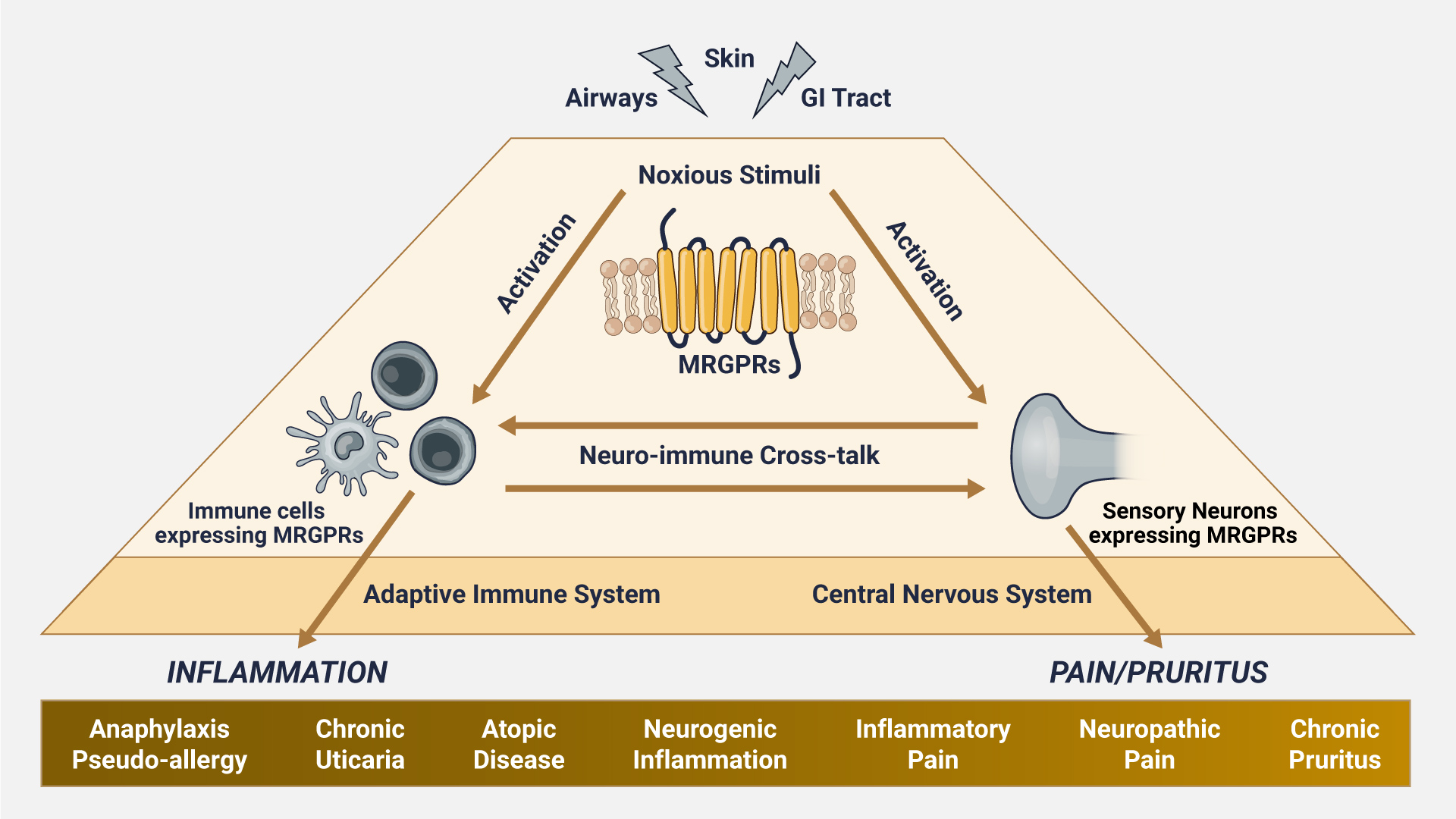Multisensory Detectors of Our Innate Neuro-immune Surveillance System
We apply state-of-the-art medicinal chemistry and biological tools to develop targeted small molecule therapeutics that hold potential to become novel, highly differentiated treatment options for a broad range of diseases.
Our initial focus is on a novel class of cell surface receptors called Mas-related G protein-coupled receptors, or MRGPRs. MRGPRs are chemosensory receptors expressed on sensory neurons and immune cells, which reside in close proximity to one another in key barrier tissues such as the skin, airways and GI tract. MRGPRs mediate the neuro-immune overactivation that is a hallmark of numerous chronic disorders, including many allergic, inflammatory, auto-immune, pain and pruritic diseases. By blocking the activation of MRGPRs with small molecule antagonists, we aim to develop highly targeted medications with novel mechanisms of action.

MRGPRs, by virtue of their ability to detect a broad range of noxious stimuli, play a key role in initiating the activation of innate immune cells and sensory neurons, as well as the crosstalk between them.
In many chronic diseases, there is an abnormal response to noxious stimuli, resulting in a vicious cycle of innate neuro-immune overactivation. This, in turn, leads to various downstream responses, mainly the recruitment of adaptive immune cells (T and B cells) and the chronic activation of pain and itch pathways in the central nervous system. Recent scientific advances indicate that neuro-immune overactivation is a core defect in disorders ranging from urticaria, atopic dermatitis and asthma to chronic syndromes of neurogenic inflammation and pain. MRGPRs are key mediators of this vicious cycle and, as such, promising targets for therapeutic intervention.
MRGPR Antagonism: A Paradigm-Changing Therapeutic Approach
Our industry-leading MRGPR platform encompasses a broad set of capabilities designed to systematically elucidate and therapeutically harness the novel biology of MRGPRs, including proprietary genetic models, GPCR-focused pharmacology and medicinal chemistry.
Blocking the Activation of MRGPRs With Potent, Highly Selective Small Molecules Holds Great Promise, Given the Potential For:
- Mechanistic Differentiation From Existing Approaches
- targeted intervention at the initiation of the neuro-inflammatory disease cascade
- Multiple Indications per Target
- once-a-day oral administration
Our most advanced pipeline programs are focused on novel antagonists targeting MRGPRX4 and MRGPRX2.
EP262 is a highly potent and selective antagonist of MRGPRX2, a receptor that mediates the activation of mast cells through a novel non-allergic pathway. MRGPRX2 is thought to be the key mediator of neurogenic inflammation. By blocking the activation of mast cells by various neuropeptides, EP262 holds great promise across a broad range of mast-cell-mediated diseases, as a once-a-day oral treatment devoid of the immuno-/myelosuppressive effects observed with other therapies.
EP547 is a highly potent and selective antagonist of MRGPRX4, a receptor expressed on sensory itch neurons that is activated by bile acids and heme metabolites. MRGPRX4 is thought to be the key mediator of cholestatic pruritus, the intense unrelenting itch experienced by many patients with cholestatic liver disease. EP547 has the potential to become the first truly targeted therapy for pruritus, as a treatment devoid of the CNS and gastrointestinal side effects observed with other approaches.
